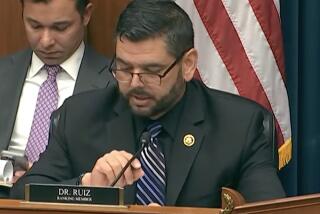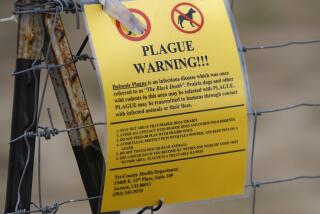From a bat, to a pig, to you — not likely
A bat settles in a palm tree, somewhere in southern China. It nibbles on a piece of fruit, and later it drops part of it in a pigpen, where it is eaten by a piglet. The piglet is slaughtered. A chef who handles the meat shakes hands with Gwyneth Paltrow, who then goes back to the U.S., visits her lover, stumbles home, shakes, foams at the mouth and dies.
And with that, a vicious viral killer begins its rampage.
This scenario from the movie “Contagion” was dreamed up by a Columbia University professor of epidemiology, W. Ian Lipkin, which gives it a veneer of scientific respectability. But could a deadly new disease really emerge this way? Uh — not likely.
It isn’t that diseases don’t cross from one species to another all the time; they do. Most human diseases are zoonoses (infections originating in animals). Smallpox, for example, began life as a rodent pox that gradually evolved into a human disease. The most vicious form of malaria, falciparum malaria, is today a human illness, but it too started life as a disease of other animals. HIV started in chimps, and it probably crossed into our species sometime in the first half of the 20th century.
All of these transformations depended on natural selection, the force that molds all living things, from pigs to parasites to people, and natural selection isn’t like flicking a switch. It’s a process. And it takes time for a disease to become efficient in a new species.
To imagine that this sort of adaptation could happen in two days is to leap onto Fantasy Island. Casual contact between species does not create new diseases in a flash. We’re supposed to think that a new virus, part of bat origin, part of pig, sprang into being like magic as the new bits of RNA re-assorted themselves in the piglet. Bingo! You’ve got a new human virus. And miracle of miracles: It explodes! All across the world!
I asked Lipkin, science advisor to the movie, to explain his thinking. Here’s how he responded in an email: “A recombination event … is what we proposed in ‘Contagion.’ A pig infected with one virus became infected by another and the two genomes combined in a single cell infected with both to form a virus with the capacity for human-to-human transmission and to cause more morbidity and mortality. Such events are eminently plausible and have been detected by sequencing a wide range of viruses.”
But if such events are “eminently plausible,” why haven’t we seen new, highly transmissible, deadly human viruses that arose this way?
It isn’t all that rare for RNA viruses to exchange genes in a cell. But to assume that a new, fully functional pathogen can arise de novo in a single pig and instantly become a lethal, highly transmissible, human-adapted virus is like believing that Aphrodite arose perfect from the foam. Mutation and recombination are only the raw material upon which natural selection acts. The “Contagion” scenario removes natural selection from the process.
The real-life inspiration for the movie was the Nipah virus, which does infect fruit bats, palm sap and pigs. Sometimes pig farmers catch it from their animals, sometimes people get it straight from palm sap that has been contaminated by infected bats. Nipah virus has been known to spread person to person, but only under conditions involving prolonged, close physical contact. In this way it’s much like Ebola, an animal virus much better adapted to its original host than to people.
To turn into an effective human pathogen, a germ has to be able to spread easily among humans. That means it has to make the human host shed it into the outside environment where it can be picked up by another host. Transmission is a subtle business, and the ability to transmit, to manipulate the host into producing symptoms that get the germ out of one body and into the next, has to evolve. That evolution can take place only by the germ cycling among people. Not bats. Not pigs. People. And enough of them that the virus gets better and better adapted to its new hosts. Only then can it turn, temporarily or permanently, into a human-adapted germ.
That process was starting to happen with SARS (severe acute respiratory syndrome), a disease that broke out of the “wet markets” of southern China in 2003 and was carried, via air travel, around the world. It infected about 8,000 people and killed 800 of them. But SARS, though a fairly lethal disease, wasn’t very effective at transmission, which occurred only late in the course of illness and chiefly in hospitals, where putting very sick people on respirators aerosolized the virus and helped it spread. Quarantine of exposed people and isolation of the sick sufficed, within months, to break the chains of transmission and drive the evolving virus out of existence.
If the filmmakers had wanted to show a novel virus breaking into humanity in a way that approximates the truth, they would have shown us SARS, a nasty, lethal but inefficient human pathogen that the oldest of methods — quarantine and isolation — sufficed to push off the Earth. But that wouldn’t have been as dramatic.
The truth is that if new diseases erupted the way that “Contagion” and its science advisors suggest, we’d all have died a long time ago. We are too much a single planet; we are 7 billion people practically sitting in each other’s laps, as science-fiction writer Robert Heinlein might say. It’s fortunate that even if filmmakers forget natural selection and its stringencies, pathogens don’t. That’s why we are still here to argue about it.
Wendy Orent is the author of “Plague: The Mysterious Past and Terrifying Future of the World’s Most Dangerous Disease.”
More to Read
A cure for the common opinion
Get thought-provoking perspectives with our weekly newsletter.
You may occasionally receive promotional content from the Los Angeles Times.










